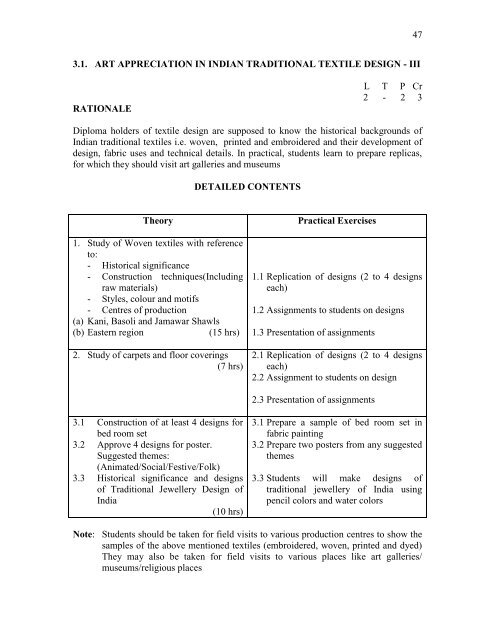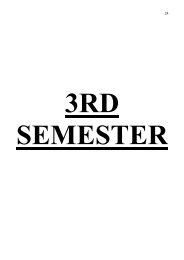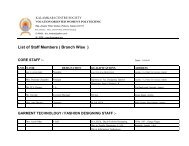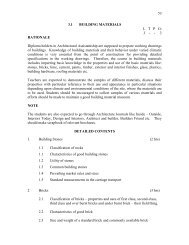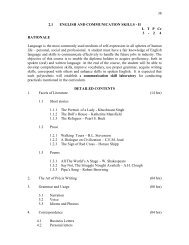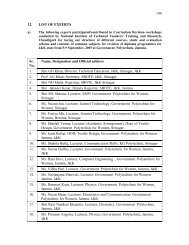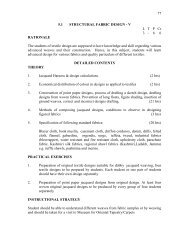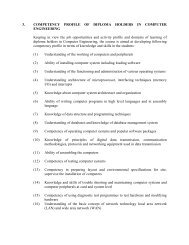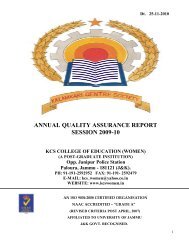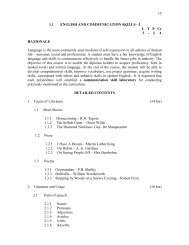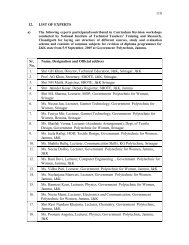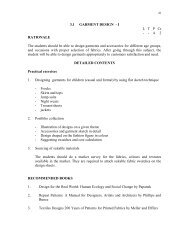3.1. art appreciation in indian traditional textile design
3.1. art appreciation in indian traditional textile design
3.1. art appreciation in indian traditional textile design
You also want an ePaper? Increase the reach of your titles
YUMPU automatically turns print PDFs into web optimized ePapers that Google loves.
47<br />
<strong>3.1.</strong> ART APPRECIATION IN INDIAN TRADITIONAL TEXTILE DESIGN - III<br />
RATIONALE<br />
L T P Cr<br />
2 - 2 3<br />
Diploma holders of <strong>textile</strong> <strong>design</strong> are supposed to know the historical backgrounds of<br />
Indian <strong>traditional</strong> <strong>textile</strong>s i.e. woven, pr<strong>in</strong>ted and embroidered and their development of<br />
<strong>design</strong>, fabric uses and technical details. In practical, students learn to prepare replicas,<br />
for which they should visit <strong>art</strong> galleries and museums<br />
DETAILED CONTENTS<br />
Theory<br />
1. Study of Woven <strong>textile</strong>s with reference<br />
to:<br />
- Historical significance<br />
- Construction techniques(Includ<strong>in</strong>g<br />
raw materials)<br />
- Styles, colour and motifs<br />
- Centres of production<br />
(a) Kani, Basoli and Jamawar Shawls<br />
(b) Eastern region<br />
(15 hrs)<br />
2. Study of carpets and floor cover<strong>in</strong>gs<br />
(7 hrs)<br />
Practical Exercises<br />
1.1 Replication of <strong>design</strong>s (2 to 4 <strong>design</strong>s<br />
each)<br />
1.2 Assignments to students on <strong>design</strong>s<br />
1.3 Presentation of assignments<br />
2.1 Replication of <strong>design</strong>s (2 to 4 <strong>design</strong>s<br />
each)<br />
2.2 Assignment to students on <strong>design</strong><br />
2.3 Presentation of assignments<br />
3.1 Construction of at least 4 <strong>design</strong>s for<br />
bed room set<br />
3.2 Approve 4 <strong>design</strong>s for poster.<br />
Suggested themes:<br />
(Animated/Social/Festive/Folk)<br />
3.3 Historical significance and <strong>design</strong>s<br />
of Traditional Jewellery Design of<br />
India<br />
(10 hrs)<br />
3.1 Prepare a sample of bed room set <strong>in</strong><br />
fabric pa<strong>in</strong>t<strong>in</strong>g<br />
3.2 Prepare two posters from any suggested<br />
themes<br />
3.3 Students will make <strong>design</strong>s of<br />
<strong>traditional</strong> jewellery of India us<strong>in</strong>g<br />
pencil colors and water colors<br />
Note: Students should be taken for field visits to various production centres to show the<br />
samples of the above mentioned <strong>textile</strong>s (embroidered, woven, pr<strong>in</strong>ted and dyed)<br />
They may also be taken for field visits to various places like <strong>art</strong> galleries/<br />
museums/religious places
48<br />
Practically execute any one of the <strong>traditional</strong> <strong>design</strong>s <strong>in</strong> the contemporary<br />
form and prepare a file with replica or samples of the given topics<br />
RECOMMENDED BOOKS<br />
1. Folk Embroidery of Himachal Pradesh by Subhash<strong>in</strong>i Aryan<br />
2. Ikat Textile of India by Chetna Desai<br />
3. Indian Pa<strong>in</strong>ted Textiles by Kamla Dev Chattopadya<br />
4. Carpets of India by Marq<br />
5. Fabric Art heritage of India by Sukla Das<br />
6. Hand Woven Fabric of India by Jasleen Dhamija<br />
7. Indian Sari by Kamla Dev Chattapodya<br />
8. Tie Dyed Textile of India by veronica Muarphy<br />
9. Hand Woven Fabrics of India by Jasleen Dhamija<br />
10. Traditional Indian Textiles by John Gillow<br />
11. Textile Art of India by Kyoto Sho<strong>in</strong><br />
12. Hand Pa<strong>in</strong>t<strong>in</strong>g Textile For the Home by Kaszz Ball and Valcrie<br />
13. Tie Dyed Textiles of India by Murphyd Crill<br />
14. Masterpieces of Indian Textile by Rustam J Mehta<br />
15. Kashmir Shawls by All India Handicrafts Board<br />
16. Everyth<strong>in</strong>g you ever wanted to know about Fabric Pa<strong>in</strong>t<strong>in</strong>g by Jill Kennedy and<br />
Jane Vourell<br />
17. Saries of India – RTZ and S<strong>in</strong>gh<br />
18. Saries of Madhya Pradesh<br />
19. Embroidered Textiles of India, Calico Masam of India<br />
20. Pa<strong>in</strong>ted Textiles of India, Calico Masam of India
49<br />
21. Pr<strong>in</strong>ted Textiles of India, Calico Masam of India<br />
22. Woven Textile of India. Calico Masam of India<br />
23. Costumes and Textiles of India by Parul Bhatnagar; Abhishek Publisher,<br />
Chandigarh<br />
24. Fabric Pa<strong>in</strong><strong>in</strong>g by Jill Kennedy Verral<br />
SUGGESTED DISTRIBUTION OF MARKS<br />
Topic No. Time Allotted (Hrs) Marks Allotted (%)<br />
1 15 50<br />
2 7 20<br />
3 10 30<br />
Total 32 100
50<br />
RATIONALE<br />
3.2 TEXTILE CALCULATIONS<br />
L T P Cr<br />
3 - - 3<br />
A diploma holder <strong>in</strong> <strong>textile</strong> <strong>design</strong> is supposed to calculate the yarn count, yarn<br />
dimensions and carry out other <strong>textile</strong> calculations related to <strong>textile</strong> <strong>design</strong><strong>in</strong>g. This<br />
subject aims at develop<strong>in</strong>g knowledge of various calculations related to yarn and fabric.<br />
Theory<br />
DETAILED CONTENTS<br />
1. Yarn number<strong>in</strong>g, (Yarn count). Various direct and <strong>in</strong>direct yarn number<strong>in</strong>g<br />
systems. Universal yarn number<strong>in</strong>g system.<br />
(10 hrs)<br />
2. Conversion of count from one yarn number<strong>in</strong>g system to another<br />
(10 hrs)<br />
3. Calculations of resultant yarn number of plied yarn and average yarn number<br />
(3 hrs)<br />
4. Calculation of yarn diameter and concept of cloth sett<strong>in</strong>g. (5 hrs)<br />
5. Cloth cover, cover factor and weight of fabric per unit area (4 hrs)<br />
6. Calculations related to cloth take-up and crimp percentage (3 hrs)<br />
7. Calculations related to weight of warp and weft required to produce given length<br />
of fabric as per given quality p<strong>art</strong>iculars.<br />
(13 hrs)<br />
INSTRUCTIONAL STRATEGY<br />
In this subject teacher is required to show different samples of fabric and make the<br />
students understand about different calculation p<strong>art</strong>iculars like count of yarn, twist <strong>in</strong> the<br />
yarn, crimp etc.<br />
RECOMMENDED BOOKS<br />
1. Weav<strong>in</strong>g Calculations by R Sen Gupta<br />
2. Sp<strong>in</strong>n<strong>in</strong>g Calculations by WS Tagg<strong>art</strong><br />
3. Handbook of Sp<strong>in</strong>n<strong>in</strong>g Calculation by TK Pattabhiram<br />
4. Advance <strong>textile</strong> <strong>design</strong>s: by William wattsons<br />
5. Textiles sciences by PK Sharma<br />
6. Woven cloth construction, Mark and Rob<strong>in</strong>son, The Textile Institute, Manchester
51<br />
SUGGESTED DISTRIBUTION OF MARKS<br />
Topic No. Time Allotted (Hrs) Marks Allotted (%)<br />
1 10 20<br />
2 10 20<br />
3 3 6<br />
4 5 10<br />
5 4 9<br />
6 3 7<br />
7 13 28<br />
Total 48 100
52<br />
RATIONALE<br />
3.3 DYEING TECHNOLOGY - I<br />
L T P Cr<br />
2 - 4 4<br />
A diploma holder <strong>in</strong> <strong>textile</strong> <strong>design</strong> must have sufficient knowledge and skills about<br />
pr<strong>in</strong>ciples of pretreatment as well as dye<strong>in</strong>g operation. Textile <strong>design</strong>er should be able to<br />
execute various recipes for dye<strong>in</strong>g and pretreatment.<br />
Theory<br />
DETAILED CONTENTS<br />
1. Introduction to dyes and dye<strong>in</strong>g (2 hrs.)<br />
2. Classification and brief idea of dyes. (3 hrs.)<br />
(Natural, Mordant & Synthetic)<br />
3. Pretreatments/Preparation of Material i.e. Fibre, yarn and fabric for<br />
Dye<strong>in</strong>g/Pr<strong>in</strong>t<strong>in</strong>g/F<strong>in</strong>ish<strong>in</strong>g<br />
(12 hrs.)<br />
• S<strong>in</strong>ge<strong>in</strong>g & Shear<strong>in</strong>g<br />
• Desiz<strong>in</strong>g<br />
• Scour<strong>in</strong>g/Degumm<strong>in</strong>g<br />
• Bleach<strong>in</strong>g<br />
• Optical brighten<strong>in</strong>g<br />
• Mercerization<br />
• Heat sett<strong>in</strong>g<br />
4. Water- Hardness and its removal (2 hrs.)<br />
• Importance of soft water <strong>in</strong> dye<strong>in</strong>g<br />
5. pH – its def<strong>in</strong>ition, function and importance <strong>in</strong> dye<strong>in</strong>g (2 hrs.)<br />
6. Dye<strong>in</strong>g of cotton with (11 hrs.)<br />
- Direct dyes<br />
- Reactive dyes<br />
- Insoluble azo colours<br />
- Vat dyes<br />
- Sulphur dyes<br />
- Union and cross Dye<strong>in</strong>g mach<strong>in</strong>e
53<br />
LIST OF PRACTICALS<br />
1. Scour<strong>in</strong>g of cotton, wool, silk and synthetics.<br />
2. Bleach<strong>in</strong>g of cotton fabric with sodium hypochlorite and H 2 O 2 (Hydrogen<br />
peroxide)<br />
3. Bleach<strong>in</strong>g of wool and silk with H 2 O 2 (Hydrogen Peroxide)<br />
4. Bleach<strong>in</strong>g of synthetics with sodium chlorite<br />
INSTRUCTIONAL STRATEGY<br />
The students should be taken to <strong>textile</strong> dye<strong>in</strong>g <strong>in</strong>dustry to show them various<br />
pretreatment and dye<strong>in</strong>g processes so that they can know various dye<strong>in</strong>g and pretreatment<br />
processes be<strong>in</strong>g used by <strong>textile</strong> <strong>in</strong>dustry.<br />
RECOMMENDED BOOKS<br />
1. Technology of Bleach<strong>in</strong>g and Mererization - VA Shenai (Vol.3 ) Sevak<br />
Publications, Mumbai<br />
2. Chemistry of Dyes and Pr<strong>in</strong>cipal of Dye<strong>in</strong>g - V.A. Shenai (Vol.2 ) Sevak<br />
Publications, Mumbai<br />
3. Dye<strong>in</strong>g and Chemical Technology of Textile Fibres, ER Trotmen Charles Griff<strong>in</strong><br />
& Co. Ltd., London<br />
4. Cotton Piece Dye<strong>in</strong>g by Shah and Gokhale, ATIRA, Ahmedabad<br />
5. Textile Chemistry Vol. II, RH Petors Elsevir Publish<strong>in</strong>g Co. London<br />
6. Technology of Dye<strong>in</strong>g –V.A. Shenai (Vol. 5), Sevak Publications, Mumbai<br />
7. Art of Dye<strong>in</strong>g – Chohan<br />
8. The Dye<strong>in</strong>g of Textile Materials – Prente Cegarra<br />
SUGGESTED DISTRIBUTION OF MARKS<br />
Topic No. Time Allotted (Hrs) Marks Allotted (%)<br />
1 2 6<br />
2 3 9<br />
3 12 37<br />
4 2 8<br />
5 2 5<br />
6 11 35<br />
Total 32 100
54<br />
RATIONALE<br />
3.4 FABRIC MANUFACTURE- I<br />
L T P Cr<br />
2 – 4 4<br />
The diploma holders <strong>in</strong> <strong>textile</strong> <strong>design</strong> are supposed to have knowledge and skills related<br />
to various looms and manufactur<strong>in</strong>g of fabric. Thus <strong>in</strong> this subject, student will learn<br />
manufactur<strong>in</strong>g techniques and mechanism employed to produce fabric.<br />
DETAILED CONTENTS<br />
Sr.<br />
Theory<br />
No<br />
.<br />
1. Introduction to yarn packages and<br />
different yarn faults<br />
(3 hrs)<br />
2. Objects of warp w<strong>in</strong>d<strong>in</strong>g and weft<br />
w<strong>in</strong>d<strong>in</strong>g, defects caused dur<strong>in</strong>g warp<br />
w<strong>in</strong>d<strong>in</strong>g and weft w<strong>in</strong>d<strong>in</strong>g. (6 hrs)<br />
3. Objects of warp<strong>in</strong>g and sectional warp<strong>in</strong>g,<br />
methods of creel<strong>in</strong>g, method of prepar<strong>in</strong>g<br />
warper’s beam .<br />
(6 hrs)<br />
4. Objects of siz<strong>in</strong>g, siz<strong>in</strong>g <strong>in</strong>gredients and<br />
their functions. Outl<strong>in</strong>e of the procedure<br />
of siz<strong>in</strong>g<br />
(6 hrs)<br />
5. Gait<strong>in</strong>g up of a warp-beam on the loom<br />
procedure of gait<strong>in</strong>g up of warp-beam.<br />
(3 hrs)<br />
6. Introduction to looms and their<br />
objectives, Nomenclature of different<br />
p<strong>art</strong>s of looms and their functions. Loom<br />
motions (primary, secondary and<br />
auxiliary motions)<br />
(3 hrs)<br />
7. Different types of sheds and their<br />
advantages and disadvantages (2 hrs)<br />
8. Introduction to different pick<strong>in</strong>g systems:<br />
(overpick and underpick ) (2 hrs)<br />
9. Beat up motions (1 hr )<br />
Practical Exercises<br />
Study of various yarn packages and<br />
yarn faults<br />
Demonstration/practice on warp and<br />
pirn w<strong>in</strong>d<strong>in</strong>g mach<strong>in</strong>e<br />
- Demonstration of different types of<br />
creels used for warp<strong>in</strong>g<br />
- Demonstration /practice of warp<strong>in</strong>g<br />
mach<strong>in</strong>e<br />
Demonstration <strong>in</strong> a Textile Mill<br />
Demonstration/Practice on gait<strong>in</strong>g up a<br />
warp<br />
Study of various p<strong>art</strong>s of loom<br />
To study different types of sheds<br />
To study different pick<strong>in</strong>g systems
55<br />
INSTRUCTIONAL STRATEGY<br />
Students may be asked to do all the work on handloom or power loom to develop the<br />
knowledge and skill <strong>in</strong> fabric manufactur<strong>in</strong>g<br />
RECOMMENDED BOOKS<br />
1. Weav<strong>in</strong>g Mechanism Vol. I and II by NN Banerjee<br />
2. Fancy Weav<strong>in</strong>g by KT Aswani<br />
3. W<strong>in</strong>d<strong>in</strong>g and Warp<strong>in</strong>g by BTRA<br />
4. Warp Siz<strong>in</strong>g by JB Smith<br />
5. Pr<strong>in</strong>ciple of Weav<strong>in</strong>g by Marks and Rob<strong>in</strong>sons<br />
6. Yarn Preparation Vol. I and II by R Sen Gupta<br />
7. Mechanism of Weav<strong>in</strong>g by WM Fox<br />
SUGGESTED DISTRIBUTION OF MARKS<br />
Topic No. Time Allotted (Hrs) Marks Allotted (%)<br />
1 3 9<br />
2 6 19<br />
3 6 19<br />
4 6 19<br />
5 3 9<br />
6 3 10<br />
7 2 6<br />
8 2 6<br />
9 1 3<br />
Total 32 100
56<br />
3.5 STRUCTURAL FABRIC DESIGN - III<br />
L T P Cr<br />
2 – 4 4<br />
RATIONALE<br />
The students of <strong>textile</strong> <strong>design</strong> are supposed to have knowledge and skill regard<strong>in</strong>g various<br />
advanced weaves and their construction. Hence, <strong>in</strong> this subject, students will learn<br />
different weaves, their method of employment to acquire competency for production of<br />
woven <strong>design</strong>s for different end uses.<br />
THEORY<br />
DETAILED CONTENTS<br />
1. Backed fabric, warp and weft backed fabric, wadded warp and weft backed<br />
fabrics their beam<strong>in</strong>g and draft<strong>in</strong>g procedure.<br />
(8 hrs)<br />
2. Double Cloth: Construction of double and triple cloth on <strong>design</strong> paper, their<br />
beam<strong>in</strong>g, draft<strong>in</strong>g and pegg<strong>in</strong>g. Types of double structure (i) Tubular fabrics<br />
(ii) double faced fabrics (iii) fabrics open<strong>in</strong>g to double the width (iv) concept<br />
of double equal pla<strong>in</strong> fabrics) triple and four ply fabrics. Warp and weft tye<strong>in</strong>g<br />
pr<strong>in</strong>ciple.(This should be shown <strong>in</strong> a <strong>textile</strong> mill or through visuals)<br />
(12 hrs)<br />
3. Introduction to gauze and leno fabrics<br />
Structure of gauze and leno fabrics; bottom and top doup<strong>in</strong>g pr<strong>in</strong>ciple. (gauze and<br />
leno structures to be shown <strong>in</strong> a <strong>textile</strong> mill or through visual). (12 hrs)<br />
PRACTICAL EXERCISES<br />
1. Study of the fabrics regard<strong>in</strong>g structure/weave and its end use:<br />
- Draper or curta<strong>in</strong> - material <strong>in</strong> natural colour with perforated weaves or<br />
different draft<strong>in</strong>g<br />
- Furnish<strong>in</strong>g fabrics (upholstery) <strong>in</strong> double cloth weaves<br />
- Bed cover, dobby weave,<br />
- P<strong>art</strong>itions and Lampshades <strong>in</strong> gauze and leno fabrics
57<br />
INSTRUCTIONAL STRATEGY<br />
Student should be able to understand different weaves from fabric samples and by<br />
weav<strong>in</strong>g. They must be taken to Textile Industries for show<strong>in</strong>g above mentioned various<br />
processes.<br />
RECOMMENDED BOOKS<br />
1. Grammer of Textile Design – Nisbet<br />
2. Structural Fabric Design by – Kilby<br />
3. Woven Structures and Design – Doris Goerner; British Textile Technology Group<br />
WIRA House, Leeds UK<br />
4. Fibre to Fabric by Ghosh<br />
5. Watson’s Advance Textile Design<br />
6. Watson’s Textile Design and Colour<br />
7. Knitt<strong>in</strong>g Technology – Spencer<br />
8. Warp Knit Fabric Construction by Charis Wildens U. Wilkens Verlog Germany<br />
9 Simple Fabric Structure by SS Satsangi<br />
SUGGESTED DISTRIBUTION OF MARKS<br />
Topic No. Time Allotted (Hrs) Marks Allotted (%)<br />
1 8 24<br />
2 12 38<br />
3 12 38<br />
Total 32 100
58<br />
RATIONALE<br />
3.6 PRINTING TECHNOLOGY - I<br />
L T P Cr<br />
3 - 4 5<br />
A diploma holder <strong>in</strong> <strong>textile</strong> <strong>design</strong> must have enough knowledge about pr<strong>in</strong>ciples and<br />
practices employed for pr<strong>in</strong>t<strong>in</strong>g. He must be aware of various operation, materials,<br />
equipments and processes used for pr<strong>in</strong>t<strong>in</strong>g.<br />
Theory<br />
DETAILED CONTENTS<br />
1. Introduction to pr<strong>in</strong>t<strong>in</strong>g (2 hrs.)<br />
2. Pr<strong>in</strong>t<strong>in</strong>g paste and its importance (3 hrs.)<br />
3. Essential constituents of pr<strong>in</strong>t<strong>in</strong>g paste and their importance (3 hrs.)<br />
4. Selection of thickeners and their properties. (3 hrs.)<br />
5. Auxiliaries used for Pr<strong>in</strong>t<strong>in</strong>g (3 hrs.)<br />
6. After-treatment of pr<strong>in</strong>ted material (10 hrs.)<br />
- Dry<strong>in</strong>g<br />
- Steam<strong>in</strong>g/age<strong>in</strong>g/cur<strong>in</strong>g<br />
- Wash<strong>in</strong>g off<br />
7. Methods of pr<strong>in</strong>t<strong>in</strong>g ( 8 hrs.)<br />
- Block pr<strong>in</strong>t<strong>in</strong>g<br />
- Stencil pr<strong>in</strong>t<strong>in</strong>g<br />
- Screen pr<strong>in</strong>t<strong>in</strong>g<br />
- Roller pr<strong>in</strong>t<strong>in</strong>g<br />
8. Introduction to Styles of pr<strong>in</strong>t<strong>in</strong>g (4 hrs.)<br />
- Direct style<br />
- Resist<br />
- Discharge<br />
- Mordant/dyed<br />
9. Pr<strong>in</strong>t<strong>in</strong>g of <strong>textile</strong>s <strong>in</strong> Direct Style of Pr<strong>in</strong>t<strong>in</strong>g: (10 hrs)<br />
- Pr<strong>in</strong>t<strong>in</strong>g of cotton with reactive dyes<br />
- Pr<strong>in</strong>t<strong>in</strong>g of cotton with vat dyes<br />
- Pr<strong>in</strong>t<strong>in</strong>g of cotton with pigments<br />
- Pr<strong>in</strong>t<strong>in</strong>g of wool & silk with acid, mordant and metal complex dyes<br />
- Pr<strong>in</strong>t<strong>in</strong>g of polyester with disperse class dye
59<br />
LIST OF PRACTICALS<br />
1. Preparation of cloth for pr<strong>in</strong>t<strong>in</strong>g<br />
2. Pr<strong>in</strong>t<strong>in</strong>g of cotton <strong>in</strong> direct style of pr<strong>in</strong>t<strong>in</strong>g with<br />
- Reactive dyes<br />
- Pigment colours<br />
- Vat dyes<br />
- Rapid fast dyes<br />
3. Pr<strong>in</strong>t<strong>in</strong>g of wool and silk <strong>in</strong> direct style of pr<strong>in</strong>t<strong>in</strong>g with<br />
- Acid dyes<br />
- Basic dyes<br />
- Metal complex dyes<br />
4. Pr<strong>in</strong>t<strong>in</strong>g of synthetic fabric <strong>in</strong> direct style of pr<strong>in</strong>t<strong>in</strong>g with<br />
- Disperse dyes<br />
- Acid dyes<br />
- Basic dyes<br />
INSTRUCTIONAL STRATEGY<br />
The students should be taken to <strong>textile</strong> pr<strong>in</strong>t<strong>in</strong>g <strong>in</strong>dustry to show them various pr<strong>in</strong>t<strong>in</strong>g<br />
processes and mach<strong>in</strong>ery so that the students can know various pr<strong>in</strong>t<strong>in</strong>g processes be<strong>in</strong>g<br />
used by <strong>textile</strong> pr<strong>in</strong>t<strong>in</strong>g <strong>in</strong>dustry.<br />
RECOMMENDED BOOKS<br />
1. Technology of Pr<strong>in</strong>t<strong>in</strong>g by VA Shenai, Sevak Publication, Mumbai<br />
2. Technology of Pr<strong>in</strong>t<strong>in</strong>g by Kalley<br />
3. A glimpse of Chemical Technology of Fibrous Materials by RR Chakravorty,<br />
Mahajan Publication, Ahmedabad<br />
4. Dye<strong>in</strong>g and Pr<strong>in</strong>t<strong>in</strong>g by Varke<br />
5. Dye<strong>in</strong>g and Pr<strong>in</strong>t<strong>in</strong>g by Jyoce storey<br />
6. Introduction to Textile Pr<strong>in</strong>t<strong>in</strong>g by Clark<br />
7. Screen Pr<strong>in</strong>t<strong>in</strong>g Designs and Technique by Biegelesien and Cohn<br />
8. Manual of Textile Pr<strong>in</strong>t<strong>in</strong>g by Story<br />
9. Textile Pr<strong>in</strong>t<strong>in</strong>g by Miles L WC, Dyers company publication Trust, Bradford,<br />
England<br />
10. Chemical Process<strong>in</strong>g of Synthetic fibres and blends, by Datye KV and Vaidye<br />
AA, John wiley and sons, New York
60<br />
SUGGESTED DISTRIBUTION OF MARKS<br />
Topic No. Time Allotted (Hrs) Marks Allotted (%)<br />
1 2 4<br />
2 3 6<br />
3 3 6<br />
4 3 6<br />
5 5 10<br />
6 10 22<br />
7 8 16<br />
8 4 8<br />
9 10 22<br />
Total 48 100
61<br />
3.7 BASICS OF INFORMATION TECHNOLOGY<br />
RATIONALE<br />
L T P Cr<br />
- - 4 2<br />
Information technology has great <strong>in</strong>fluence on all aspects of life. Almost all work places<br />
and liv<strong>in</strong>g environment are be<strong>in</strong>g computerized. In order to prepare diploma holders to<br />
work <strong>in</strong> these environments, it is essential that they are exposed to various aspects of<br />
<strong>in</strong>formation technology such as understand<strong>in</strong>g the concept of <strong>in</strong>formation technology and<br />
its scope; operat<strong>in</strong>g a computer; use of various tools of MS office; us<strong>in</strong>g <strong>in</strong>ternet etc. form<br />
the broad competency profile of diploma holders. This exposure will enable the students<br />
to enter their professions with confidence, live <strong>in</strong> a harmonious way and contribute to the<br />
productivity.<br />
Note: i) Teach<strong>in</strong>g of theory should be dovetailed with practical work.<br />
ii) The follow<strong>in</strong>g topics be kept <strong>in</strong> m<strong>in</strong>d while do<strong>in</strong>g practical exercises <strong>in</strong> the<br />
laboratory.<br />
DETAILED CONTENTS<br />
Instructions for Practical Exercises<br />
1. Information Technology – its concept and scope<br />
2. Elements of a computer system, its usefulness and applications, block diagram of<br />
a computer, CPU, memory, data – numeric data, alpha numeric data; contents of<br />
a program, process<strong>in</strong>g of data<br />
3. Computer organization, computer hardware and software; primary and secondary<br />
memory: RAM, ROM, PROM etc.<br />
4. Input devices; keyboard, scanner, mouse etc ; output devices ; VDU and Pr<strong>in</strong>ter,<br />
Plotter<br />
5. Primary and Secondary Storage (Auxiliary Storage), Secondary storage; magnetic<br />
disks – tracks and sectors, optical disk (CD, CD-RW and DVD Memory)<br />
6. Introduction to Operat<strong>in</strong>g Systems such as MS-DOS and W<strong>in</strong>dows<br />
7. Introduction to <strong>in</strong>ternet, brows<strong>in</strong>g us<strong>in</strong>g search eng<strong>in</strong>e (like google etc. )<br />
8. Basics of Network<strong>in</strong>g – LAN, WAN, Topologies<br />
LIST OF PRACTICALS<br />
1. Given a PC, name its various components and list their functions<br />
2. Identification of various p<strong>art</strong>s of a computer and peripherals<br />
3. Practice <strong>in</strong> <strong>in</strong>stall<strong>in</strong>g a computer system by giv<strong>in</strong>g connection<br />
4. DOS Commands (<strong>in</strong>ternal / external) e.g. TYPE, REN, DEL, CD, MD, COPY,<br />
TREE, BACKUP<br />
5. Exercises on enter<strong>in</strong>g text and data (Typ<strong>in</strong>g Practice us<strong>in</strong>g any tutor)<br />
6. Features of W<strong>in</strong>dows as an operat<strong>in</strong>g system
- St<strong>art</strong><br />
- Shutdown and restore<br />
- Creat<strong>in</strong>g and operat<strong>in</strong>g on the icons<br />
- Open<strong>in</strong>g clos<strong>in</strong>g and siz<strong>in</strong>g the w<strong>in</strong>dows<br />
- Us<strong>in</strong>g elementary job commands like – creat<strong>in</strong>g, sav<strong>in</strong>g,<br />
modify<strong>in</strong>g, renam<strong>in</strong>g, f<strong>in</strong>d<strong>in</strong>g and delet<strong>in</strong>g a file<br />
- Creat<strong>in</strong>g and operat<strong>in</strong>g on a folder<br />
- Chang<strong>in</strong>g sett<strong>in</strong>g like, date, time color (back ground and fore<br />
ground)<br />
- Us<strong>in</strong>g short cuts<br />
- Us<strong>in</strong>g on l<strong>in</strong>e help<br />
7. MS-Word<br />
- File Management:<br />
Open<strong>in</strong>g, creat<strong>in</strong>g and sav<strong>in</strong>g a document, locat<strong>in</strong>g files, copy<strong>in</strong>g contents<br />
<strong>in</strong> some different file(s), protect<strong>in</strong>g files, Giv<strong>in</strong>g password protection for a<br />
file<br />
- Page Set up:<br />
Sett<strong>in</strong>g marg<strong>in</strong>s, tab sett<strong>in</strong>g, ruler, <strong>in</strong>dent<strong>in</strong>g<br />
- Edit<strong>in</strong>g a document:<br />
Enter<strong>in</strong>g text, Cut, copy, paste us<strong>in</strong>g tool- bars<br />
- Formatt<strong>in</strong>g a document:<br />
Us<strong>in</strong>g different fonts, chang<strong>in</strong>g font size and colour, chang<strong>in</strong>g the<br />
appearance through bold/ italic/ underl<strong>in</strong>ed, highlight<strong>in</strong>g a text, chang<strong>in</strong>g<br />
case, us<strong>in</strong>g subscript and superscript, us<strong>in</strong>g different underl<strong>in</strong>e methods<br />
- Align<strong>in</strong>g of text <strong>in</strong> a document, justification of document, Insert<strong>in</strong>g bullets<br />
and number<strong>in</strong>g<br />
- Formatt<strong>in</strong>g paragraph, <strong>in</strong>sert<strong>in</strong>g page breaks and column breaks, l<strong>in</strong>e<br />
spac<strong>in</strong>g<br />
- Use of headers, footers: Insert<strong>in</strong>g footnote, end note, use of comments<br />
- Insert<strong>in</strong>g date, time, special symbols, import<strong>in</strong>g graphic images, draw<strong>in</strong>g<br />
tools<br />
- Tables and Borders:<br />
Creat<strong>in</strong>g a table, formatt<strong>in</strong>g cells, use of different border styles, shad<strong>in</strong>g <strong>in</strong><br />
tables, merg<strong>in</strong>g of cells, p<strong>art</strong>ition of cells, <strong>in</strong>sert<strong>in</strong>g and delet<strong>in</strong>g a row <strong>in</strong> a<br />
table<br />
- Pr<strong>in</strong>t preview, zoom, page set up, pr<strong>in</strong>t<strong>in</strong>g options<br />
- Us<strong>in</strong>g F<strong>in</strong>d, Replace options<br />
- Us<strong>in</strong>g Tools like:<br />
Spell checker, help, use of macros, mail merge, thesaurus word content and<br />
statistics, pr<strong>in</strong>t<strong>in</strong>g envelops and labels<br />
- Us<strong>in</strong>g shapes and draw<strong>in</strong>g toolbar,<br />
- Work<strong>in</strong>g with more than one w<strong>in</strong>dow <strong>in</strong> MS Word,<br />
- How to change the version of the document from one w<strong>in</strong>dow OS to<br />
another<br />
- Conversion between different text editors, software and MS word<br />
62
63<br />
8. MS-Excel<br />
- St<strong>art</strong><strong>in</strong>g excel, open worksheet, enter, edit, data, formulae to calculate<br />
values, format data, create ch<strong>art</strong>, pr<strong>in</strong>t<strong>in</strong>g ch<strong>art</strong>, save worksheet, switch<strong>in</strong>g<br />
between different spread sheets<br />
- Menu commands:<br />
Create, format ch<strong>art</strong>s, organize, manage data, solv<strong>in</strong>g problem by<br />
analyz<strong>in</strong>g data, exchange with other applications. Programm<strong>in</strong>g with MS-<br />
Excel, gett<strong>in</strong>g <strong>in</strong>formation while work<strong>in</strong>g<br />
- Work books:<br />
Manag<strong>in</strong>g workbooks (create, open, close, save), work<strong>in</strong>g <strong>in</strong> work books,<br />
select<strong>in</strong>g the cells, choos<strong>in</strong>g commands, data entry techniques, formula<br />
creation and l<strong>in</strong>ks, controll<strong>in</strong>g calculations, work<strong>in</strong>g with arrays<br />
- Edit<strong>in</strong>g a worksheet, copy<strong>in</strong>g, mov<strong>in</strong>g cells, past<strong>in</strong>g, <strong>in</strong>sert<strong>in</strong>g, deletion<br />
cells, rows, columns, f<strong>in</strong>d and replace text, numbers of cells, formatt<strong>in</strong>g<br />
worksheet<br />
- Creat<strong>in</strong>g a ch<strong>art</strong>:<br />
Work<strong>in</strong>g with ch<strong>art</strong> types, chang<strong>in</strong>g data <strong>in</strong> ch<strong>art</strong>, formatt<strong>in</strong>g a ch<strong>art</strong>, use<br />
ch<strong>art</strong> to analyze data<br />
- Us<strong>in</strong>g a list to organize data, sort<strong>in</strong>g and filter<strong>in</strong>g data <strong>in</strong> list<br />
9. MS PowerPo<strong>in</strong>t<br />
a) Introduction to PowerPo<strong>in</strong>t<br />
- How to st<strong>art</strong> PowerPo<strong>in</strong>t<br />
- Work<strong>in</strong>g environment: concept of toolbars, slide layout, templates<br />
etc.<br />
- Open<strong>in</strong>g a new/exist<strong>in</strong>g presentation<br />
- Different views for view<strong>in</strong>g slides <strong>in</strong> a presentation: normal, slide<br />
sorter etc.<br />
b) Addition, deletion and sav<strong>in</strong>g of slides<br />
e) How to view the slide show?<br />
- View<strong>in</strong>g the presentation us<strong>in</strong>g slide navigator<br />
- Slide transition<br />
- Animation effects etc.<br />
10. Internet and its Applications<br />
a) Log-<strong>in</strong> to <strong>in</strong>ternet<br />
b) Navigation for <strong>in</strong>formation seek<strong>in</strong>g on <strong>in</strong>ternet<br />
c) Brows<strong>in</strong>g and down load<strong>in</strong>g of <strong>in</strong>formation from <strong>in</strong>ternet<br />
d) Send<strong>in</strong>g and receiv<strong>in</strong>g e-mail<br />
- Creat<strong>in</strong>g a message<br />
- Creat<strong>in</strong>g an address book<br />
- Attach<strong>in</strong>g a file with e-mail message<br />
- Receiv<strong>in</strong>g a message<br />
- Delet<strong>in</strong>g a message
64<br />
RECOMMENDED BOOKS<br />
1. Fundamentals of Computer by V . Rajaraman; Prentice Hall of India Pvt. Ltd., New<br />
Delhi<br />
2. Computers Today by SK Basandara, Galgotia Publication Pvt ltd. Daryaganj, New<br />
Delhi.<br />
3. MS-Office 2000 for Everyone by Sanjay Saxena; Vikas Publish<strong>in</strong>g House Pvt. Ltd.,<br />
New Delhi<br />
4. Internet for Every One by Alexis Leon and Mathews Leon; Vikas Publish<strong>in</strong>g House<br />
Pvt. Ltd., Jungpura, New Delhi<br />
5. A First Course <strong>in</strong> Computer by Sanjay Saxena; Vikas Publish<strong>in</strong>g House Pvt. Ltd.,<br />
Jungpura,New Delhi<br />
6. Master<strong>in</strong>g W<strong>in</strong>dows 95, BPB Publication, New Delhi<br />
7. Computer Fundamentals by PK S<strong>in</strong>ha; BPB Publication, New Delhi<br />
8. Fundamentals of Information Technology by Leon and Leon;Vikas Publish<strong>in</strong>g House<br />
Pvt. Ltd., Jungpura, New Delhi<br />
9. On Your Marks - Net…Set…Go… Surviv<strong>in</strong>g <strong>in</strong> an e-world by Anushka Wiras<strong>in</strong>ha,<br />
Prentice Hall of India Pvt. Ltd., New Delhi<br />
10. Learn<strong>in</strong>g MS Office XP by Ramesh Bangia, Khanna Book Publish<strong>in</strong>g Co. (P) Ltd.,<br />
New Delhi.<br />
11. Fundamentals of Information Technology by Vip<strong>in</strong> Arora, Eagle Parkashan, Jalandhar
65<br />
ECOLOGY AND ENVIRONMENTAL AWARENESS CAMP<br />
A diploma holder must have knowledge of different types of pollution caused due to<br />
<strong>in</strong>dustries and constructional activities so that he may help <strong>in</strong> balanc<strong>in</strong>g the eco system<br />
and controll<strong>in</strong>g pollution by pollution control measures. He should also be aware of<br />
environmental laws related to the control of pollution.<br />
This is to be organized at a stretch for 3 to 4 days. Lectures will be delivered on<br />
follow<strong>in</strong>g broad topics. There will be no exam<strong>in</strong>ation for this subject.<br />
1. Basics of ecology, eco system and susta<strong>in</strong>able development<br />
2. Conservation of land reforms, preservation of species, prevention of advancement<br />
of deserts and lower<strong>in</strong>g of water table<br />
3. Sources of pollution - natural and man made, their effects on liv<strong>in</strong>g and non-liv<strong>in</strong>g<br />
organisms<br />
4. Pollution of water - causes, effects of domestic wastes and <strong>in</strong>dustrial effluent on<br />
liv<strong>in</strong>g and non-liv<strong>in</strong>g organisms<br />
5. Pollution of air-causes and effects of man, animal, vegetation and non-liv<strong>in</strong>g<br />
organisms<br />
6. Sources of noise pollution and its effects<br />
7. Solid waste management; classification of refuse material, types, sources and<br />
properties of solid wastes, abatement methods<br />
8. M<strong>in</strong><strong>in</strong>g, blast<strong>in</strong>g, deforestation and their effects<br />
9. Legislation to control environment<br />
10. Environmental Impact Assessment (EIA), Elements for prepar<strong>in</strong>g EIA statements<br />
11. Current issues <strong>in</strong> environmental pollution and its control<br />
12. Role of non-conventional sources of energy <strong>in</strong> environmental protection


